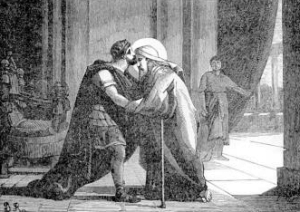 Saint Paphnutius
Saint Paphnutius
Bishop († Second half of the Fourth Century)
Feast – September 11
The Romans thought of themselves as highly religious and attributed their success as a world power to their collective piety in maintaining good relations with pagan gods.
The political, cultural and religious coherence of an emergent Roman super-state required a broad, inclusive and flexible network of lawful cults. At different times and in different places, the sphere of influence, character and functions of a divine being could expand, overlap with those of others, and be redefined as Roman.
Roman theology acknowledged that immortal gods ruled all realms of the heavens and earth, but their favor could be bought by anyone, regardless of their behavior and moral standing. When a person needed or desired something, they would provide an offering to the god specializing in this field, in the respective temple. If successful, the individual would return to perform another offering. The Priests of these temples, with help of demons, worked to keep the money flowing and ensure the scam was successful. This meant they had to prevent conversion to the one real God, the creator of everything, who can’t be bribed, and who is just and merciful at the same time. The God proclaimed by the Holy Catholic Church which leads to the salvation of souls and eternal happiness, rather than material prosperity and earthly pleasures. Thus, despite being tolerant and inclusive of every other religion and cult, the Romans adamantly opposed the Catholic Church for three hundred years.
One of persecuted who was fortunate enough to see the Catholic Church victorious over the Roman Empire’s paganism was St. Paphnutius.
While there is no record of St. Paphnutius’ early life, it is known that he was an Egyptian, and a disciple of the father of traditional Christian monasticism, the great St. Anthony of the Desert. Having spent several years pursuing spiritual illumination in the austerity of the desert, St. Paphnutius was chosen to become a bishop for the Upper Thebaid region. This placed him in direct conflict with the Roman imperial ruler of Egypt and Syria (305 – 313), the Pharaoh of Egypt, the mediator between the pagan gods and the world of men, Galerius Valerius Maximinus Daia (Daza).
Under Galerius’ tyrannic rule, St. Paphnutius had his left leg hamstrung (method of torture by severing the hamstring tendons in the thigh of the individual which results not only in the crippling of the leg, but also in pain) and his right eye gouged out, in an unsuccessful effort to make him renounce the Catholic faith. Not yielding before torture, he was condemned to manual labor in the mines.
In 311, during a power struggle between various co-emperors, Imperial policy toward Christians shifted towards violence. Only after Roman Emperor Constantine and Emperor Licinius, who controlled the Balkans, met in Mediolanum in February 313 AD was peace restored to the Church. Among the discussions during their meeting, the two Emperors agreed to treat Christians benevolently within the Roman Empire. The meeting resulted in the Edict of Milan, which gave Christianity legal status and a reprieve from persecution, enabling St. Paphnutius to return to his flock.
When the Arian heresy was being broached in Egypt, St. Paphnutius was one of the most zealous in defending the Catholic faith. His eminent sanctity and glorious title of confessor (one who had confessed the faith before persecutors and under torments) was influential and is reputed to have played a role at the First Ecumenical Council of Nice, held in 325, which condemned Arianism and promulgated the Nicene Creed.
At the Synod St. Paphnutius spared the Catholic Church a lot of anxiety and trouble. It was proposed that celibacy should be implemented generally for all the clergy.At face value the suggestion was considered reasonable, but few evaluated the consequences of adding this requirement.
During this time it was necessary to select bishops, priests and deacons from the elder Catholics in town, but many of them were already married. Implementing mandatory celibacy would create a shortage of candidates, preventing the needs of the Church from being fulfilled and necessitating a decline in the quality of priests. Simultaneously, this mandate was contrary to a recommendation made by St. Paul during similar apostolic times: Timothy 3;2,4-5 “Therefore, a bishop must be irreproachable, married only once, temperate, self-controlled, decent, hospitable, able to teach …He must manage his own household well, keeping his children under control with perfect dignity; for if a man does not know how to manage his own household, how can he take care of the church of God?”
 Since the majority of the bishops present belonged to the married clergy, imposing a requirement of celibacy on new appointees would appear hypocritical and undermine the prestige of the Church.
Since the majority of the bishops present belonged to the married clergy, imposing a requirement of celibacy on new appointees would appear hypocritical and undermine the prestige of the Church.
Due in part to the intense opposition from St. Paphnutius, who was celibate himself, the proposal was not enacted.
Emperor Constantine, during the celebration of that synod, frequently conferred privately with St.Paphnutius in his palace, and never dismissed him without kissing respectfully the place which had once held the eye St. Paphnutius had lost for the faith.
Saint Paphnutius remained a close friend to Saint Athanasius, and accompanied him to the Council of Tyre, in 335, where they found a large assembly of professed Arians. Seeing Maximus the Bishop of Jerusalem among them the heretics, Paphnutius took him by the hand, led him out, and told him he could not see that any who bore the same marks as he in defence of the faith should be seduced and imposed upon by persons who were resolved to oppress the most strenuous assertor of its fundamental article.
We have no particular account of the death of Saint Paphnutius; but his name stands in the Roman Martyrology on the 11th of September.
References and Excerpts:
[1] CNA, “St. Paphnutius,” Catholic News Agency. https://www.catholicnewsagency.com/saint/st-paphnutius-709 (accessed Sep. 16, 2023).
[2] “CatholicSaints.Info » Blog Archive » Pictorial Lives of the Saints – Saint Paphnutius, Bishop.” https://catholicsaints.info/pictorial-lives-of-the-saints-saint-paphnutius-bishop/ (accessed Sep. 16, 2023).
[3] “Paphnutius of Thebes,” Wikipedia. Aug. 12, 2022. Accessed: Sep. 16, 2023. [Online]. Available: https://en.wikipedia.org/w/index.php?title=Paphnutius_of_Thebes&oldid=1104082378
[4] “A Monk Defends the Marriage of the Clergy,” PEMPTOUSIA, Dec. 10, 2013. https://pemptousia.com/2013/12/a-monk-defends-the-marriage-of-the-clergy/ (accessed Sep. 16, 2023).